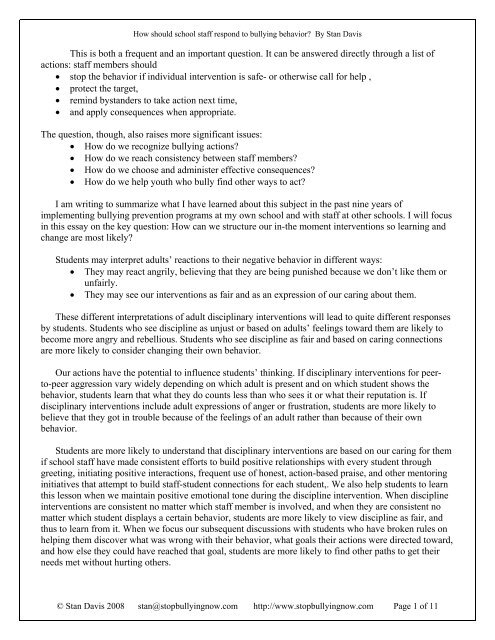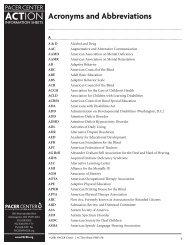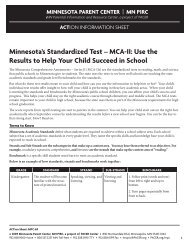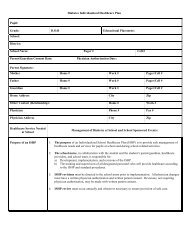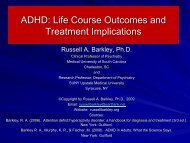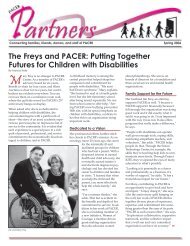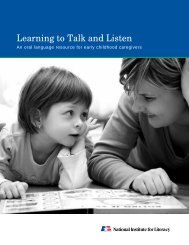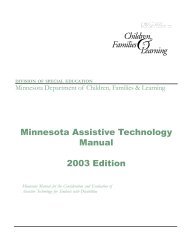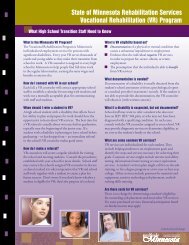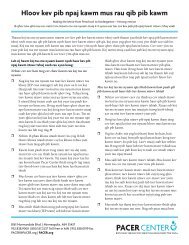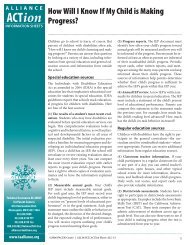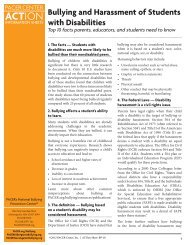How should school staff respond to bullying ... - PACER Center
How should school staff respond to bullying ... - PACER Center
How should school staff respond to bullying ... - PACER Center
- No tags were found...
You also want an ePaper? Increase the reach of your titles
YUMPU automatically turns print PDFs into web optimized ePapers that Google loves.
<strong>How</strong> <strong>should</strong> <strong>school</strong> <strong>staff</strong> <strong>respond</strong> <strong>to</strong> <strong>bullying</strong> behavior? By Stan DavisThis is both a frequent and an important question. It can be answered directly through a list ofactions: <strong>staff</strong> members <strong>should</strong>• s<strong>to</strong>p the behavior if individual intervention is safe- or otherwise call for help ,• protect the target,• remind bystanders <strong>to</strong> take action next time,• and apply consequences when appropriate.The question, though, also raises more significant issues:• <strong>How</strong> do we recognize <strong>bullying</strong> actions?• <strong>How</strong> do we reach consistency between <strong>staff</strong> members?• <strong>How</strong> do we choose and administer effective consequences?• <strong>How</strong> do we help youth who bully find other ways <strong>to</strong> act?I am writing <strong>to</strong> summarize what I have learned about this subject in the past nine years ofimplementing <strong>bullying</strong> prevention programs at my own <strong>school</strong> and with <strong>staff</strong> at other <strong>school</strong>s. I will focusin this essay on the key question: <strong>How</strong> can we structure our in-the moment interventions so learning andchange are most likely?Students may interpret adults’ reactions <strong>to</strong> their negative behavior in different ways:• They may react angrily, believing that they are being punished because we don’t like them orunfairly.• They may see our interventions as fair and as an expression of our caring about them.These different interpretations of adult disciplinary interventions will lead <strong>to</strong> quite different responsesby students. Students who see discipline as unjust or based on adults’ feelings <strong>to</strong>ward them are likely <strong>to</strong>become more angry and rebellious. Students who see discipline as fair and based on caring connectionsare more likely <strong>to</strong> consider changing their own behavior.Our actions have the potential <strong>to</strong> influence students’ thinking. If disciplinary interventions for peer<strong>to</strong>-peeraggression vary widely depending on which adult is present and on which student shows thebehavior, students learn that what they do counts less than who sees it or what their reputation is. Ifdisciplinary interventions include adult expressions of anger or frustration, students are more likely <strong>to</strong>believe that they got in trouble because of the feelings of an adult rather than because of their ownbehavior.Students are more likely <strong>to</strong> understand that disciplinary interventions are based on our caring for themif <strong>school</strong> <strong>staff</strong> have made consistent efforts <strong>to</strong> build positive relationships with every student throughgreeting, initiating positive interactions, frequent use of honest, action-based praise, and other men<strong>to</strong>ringinitiatives that attempt <strong>to</strong> build <strong>staff</strong>-student connections for each student,. We also help students <strong>to</strong> learnthis lesson when we maintain positive emotional <strong>to</strong>ne during the discipline intervention. When disciplineinterventions are consistent no matter which <strong>staff</strong> member is involved, and when they are consistent nomatter which student displays a certain behavior, students are more likely <strong>to</strong> view discipline as fair, andthus <strong>to</strong> learn from it. When we focus our subsequent discussions with students who have broken rules onhelping them discover what was wrong with their behavior, what goals their actions were directed <strong>to</strong>ward,and how else they could have reached that goal, students are more likely <strong>to</strong> find other paths <strong>to</strong> get theirneeds met without hurting others.© Stan Davis 2008 stan@s<strong>to</strong>p<strong>bullying</strong>now.com http://www.s<strong>to</strong>p<strong>bullying</strong>now.com Page 1 of 11
<strong>How</strong> <strong>should</strong> <strong>school</strong> <strong>staff</strong> <strong>respond</strong> <strong>to</strong> <strong>bullying</strong> behavior? By Stan DavisOlweus, Limber, and Mihalic summarize this approach <strong>to</strong> intervention well when they state:“The [<strong>bullying</strong> prevention] program strives <strong>to</strong> develop a <strong>school</strong> (and ideally a home)environment characterized by:• warmth, positive interest, and involvement by adults;• firm limits <strong>to</strong> unacceptable behavior;• non-hostile, nonphysical negative consequences consistently applied in cases of...unacceptable behaviors; and• where adults act as authorities and positive role models.”(Olweus,Limber, Mihalic 1999)When I discussed this statement with Dr. Olweus, he <strong>to</strong>ld me he had been influenced by the work ofDiana Baumrind, the American psychologist who identified two dimensions of effective parenting:consistent discipline and supervision, and warmth and connectedness. Baumrind’s research identified fourparenting styles, as shown in the chart below:© Stan Davis 2008 stan@s<strong>to</strong>p<strong>bullying</strong>now.com http://www.s<strong>to</strong>p<strong>bullying</strong>now.com Page 2 of 11
<strong>How</strong> <strong>should</strong> <strong>school</strong> <strong>staff</strong> <strong>respond</strong> <strong>to</strong> <strong>bullying</strong> behavior? By Stan DavisIn long-term follow-up research with children who had been raised in these four types of families,Baumrind (and others who have replicated her work), found these outcomes:Olweus’s research, which has found that boosting warmth, connectedness, and disciplinaryconsistency in <strong>school</strong>s has led <strong>to</strong> marked declines in rates of <strong>bullying</strong>, makes clear the importance of thesetwo principles: connectedness and consistency. Based on my experience implementing <strong>bullying</strong>prevention over the past ten years, I am convinced that these two principles hold the key <strong>to</strong> our work. Ourgoal, then, <strong>should</strong> be <strong>to</strong> implement disciplinary approaches that build student perceptions that <strong>staff</strong> areusing discipline <strong>to</strong> help them learn and grow, and that students see our disciplinary interventions as fair.Both of these goals connect with the original meaning of the word “discipline” which derives from thesame linguistic roots as the word “disciple.” Effective discipline teaches. As the principal of the <strong>school</strong>where I work, Nancy Reynolds, often states: “Our rules and consequences here are all about learning. Wecare less about what you have done than about what you will do in the future.”<strong>How</strong>, then, can we design and implement discipline interventions that are based on caring andconsistency? Let’s begin with a specific event. Just before my <strong>school</strong>’s April vacation, we held a “beachday” in the gymnasium. There was still snow on the ground in Maine, where I live, and the kids hadn’tgone out for a few days. Students ate their lunches on mats and beach <strong>to</strong>wels, wore sunglasses, anddanced <strong>to</strong> the music of the Beach Boys. As I was moving around the gym talking with students, onestudent ran across the gym and kicked another student. I had <strong>to</strong> figure out what <strong>to</strong> do. For the reasonsdescribed above, it was important <strong>to</strong> me <strong>to</strong> use an intervention that was consistent with other <strong>staff</strong>members’ actions and which either built my connection with the student who shoved or at least did notharm that relationship. I also wanted him not <strong>to</strong> kick again.What adults do in a situation like this depends partly on what we call this action. Three commonlabels we might use <strong>to</strong> describe this act are conflict, horseplay, or <strong>bullying</strong>. These different labels wouldlead us <strong>to</strong> intervene in different ways. One well-respected definition of <strong>bullying</strong> we might use <strong>to</strong> make thedistinction is Dorothea Ross’s:© Stan Davis 2008 stan@s<strong>to</strong>p<strong>bullying</strong>now.com http://www.s<strong>to</strong>p<strong>bullying</strong>now.com Page 3 of 11
<strong>How</strong> <strong>should</strong> <strong>school</strong> <strong>staff</strong> <strong>respond</strong> <strong>to</strong> <strong>bullying</strong> behavior? By Stan DavisBullying is a form of social interaction—not necessarily long-standing—in which a moredominant individual (the bully) exhibits aggressive behavior that is intended <strong>to</strong>, and does, in fact,cause distress <strong>to</strong> a less dominant individual (the target). The aggressive behavior may take theform of a direct physical and/or verbal attack or may be indirect. More than one bully and morethan one target may participate in the interaction.Dorothea Ross, Childhood Bullying and Teasing (ACA, 1996)When we look at this definition, there are three elements that I have consistently found verydifficult <strong>to</strong> be sure of:- <strong>How</strong> am I <strong>to</strong> know which of these two students is more dominant socially?- <strong>How</strong> am I <strong>to</strong> know what the kicker intends? Many young people say convincingly that did notmean <strong>to</strong> cause distress- that they were “just playing.”- <strong>How</strong> am I <strong>to</strong> know if the action does cause distress <strong>to</strong> the target? Some young people showgreat distress if a friend plays with someone else for one recess; others do not let us know theyare distressed even if something very serious is done <strong>to</strong> them.As I see it, <strong>school</strong> <strong>staff</strong> are often asked <strong>to</strong> make distinctions between many possible labels forbehavior, even though these categories of behavior are not easily distinguished in real situations.Some of the categories of behavior we could place this, or any negative peer action in, are shown onthe following diagram:All the circles but the center one are surrounded by dotted lines, because in my experience all thesedistinctions are based on adults’ assumptions and judgments, not on objective criteria. Thus placing anaction, like that shove, in one category or another is difficult <strong>to</strong> do with any degree of certainty or fairness.In my experience, if we tell parents their child has bullied another child, we are likely <strong>to</strong> hear “She is not abully,” or “I know he didn’t mean any harm.” If we mislabel <strong>bullying</strong> as a quarrel or as horseplay, wemay sit the two children down <strong>to</strong>gether <strong>to</strong> talk- and thus risk solidifying the <strong>bullying</strong> youth’s power overthe target- or tell the target <strong>to</strong> handle the situation him or her-self, and thus put the target at risk of beinghurt again.© Stan Davis 2008 stan@s<strong>to</strong>p<strong>bullying</strong>now.com http://www.s<strong>to</strong>p<strong>bullying</strong>now.com Page 4 of 11
<strong>How</strong> <strong>should</strong> <strong>school</strong> <strong>staff</strong> <strong>respond</strong> <strong>to</strong> <strong>bullying</strong> behavior? By Stan DavisInstead of focusing on whether a specific action is <strong>bullying</strong> or not, I have found it more useful <strong>to</strong> lookat negative peer <strong>to</strong> peer behaviors in a different way.Note that the large circle of negative actions <strong>to</strong>ward peers includes an outer ring of behaviors that arenegative yet acceptable at <strong>school</strong>. An example may help <strong>to</strong> clarify this concept. When I was sixteen yearsold, my girlfriend broke up with me. She <strong>to</strong>ld me that she never wanted <strong>to</strong> go out with me again. Thisaction had a marked negative effect on me. I s<strong>to</strong>pped doing my <strong>school</strong>work; I s<strong>to</strong>pped sleeping well; Ithought seriously about killing myself. Even though this action had a clear negative effect, was done by amore popular student, and was done <strong>to</strong> a less popular student, I cannot imagine a <strong>school</strong> in which a <strong>staff</strong>member would tell this young woman that she had <strong>to</strong> start going out with me again or risk having adetention. We see parallel actions in Elementary <strong>school</strong>s when a friend decides <strong>to</strong> s<strong>to</strong>p being best friendswith another student. The student who is the “target” of this behavior may be distressed. Unless the otherstudent goes on <strong>to</strong> do other cruel things <strong>to</strong> his or her former friend, though, I believe educa<strong>to</strong>rs have nobusiness intervening through disciplinary action in this situation.Within this outer circle of behavior which may have negative effects but are seen as acceptable, thereare other actions which are both negative in impact and unacceptable at <strong>school</strong>. An example might bespreading rumors about a classmate, calling names or making threats focused on sexual orientation, orpunching another student. In addition, some of these unacceptable behaviors are also illegal- they fallwithin the legal definition of harassment, criminal threatening, assault, or other criminal acts.© Stan Davis 2008 stan@s<strong>to</strong>p<strong>bullying</strong>now.com http://www.s<strong>to</strong>p<strong>bullying</strong>now.com Page 5 of 11
<strong>How</strong> <strong>should</strong> <strong>school</strong> <strong>staff</strong> <strong>respond</strong> <strong>to</strong> <strong>bullying</strong> behavior? By Stan DavisDistinguishing between behaviors in this way makes fair, consistent responses by <strong>staff</strong> more possible.To respect the wide range of different behaviors we are dealing this, I recommend that we make one moreset of distinctions, shown in the following diagram:This diagram has additional categories covering actions which may be unacceptable in some situationsand acceptable in others and actions which are unacceptable <strong>school</strong>wide but are not the most severe. Wecan integrate <strong>staff</strong>, student, and parent input <strong>to</strong> differentiate between GRAY behaviors, which may or maynot be acceptable based on age or context, YELLOW behaviors, which are unacceptable <strong>school</strong>wide andwhich are <strong>to</strong> be dealt with in the moment by whichever <strong>staff</strong> member sees or hears them, ORANGEbehaviors for which we intervene in the moment and also keep track of, and RED behaviors, for which weintervene in the moment and also report <strong>to</strong> the administra<strong>to</strong>r for action. When <strong>school</strong>s reach consensusabout which specific behaviors fall in each of these categories, they are much more able <strong>to</strong> work <strong>to</strong>wardconsistent and fair <strong>staff</strong> responses.© Stan Davis 2008 stan@s<strong>to</strong>p<strong>bullying</strong>now.com http://www.s<strong>to</strong>p<strong>bullying</strong>now.com Page 6 of 11
<strong>How</strong> <strong>should</strong> <strong>school</strong> <strong>staff</strong> <strong>respond</strong> <strong>to</strong> <strong>bullying</strong> behavior? By Stan DavisFor ORANGE behaviors we would use the same in-the-moment interventions as for YELLOWbehaviors. In addition we would track these behaviors by having all <strong>staff</strong> report them <strong>to</strong> the student’shomeroom teacher, team leader, or advisor. That person would then be responsible <strong>to</strong> keep track of thenumber of these actions reported and <strong>to</strong> inform the administra<strong>to</strong>r when a student has chosen anycombination of ORANGE behaviors three times. That report would then lead <strong>to</strong> administrative action.For RED behaviors- that is, actions the <strong>staff</strong> and students have determined are the most serious andmost likely <strong>to</strong> harm physically or emotionally, I believe we are most effective with a predictable, rubricbaseddiscipline system as described in Schools Where Everyone Belongs. In this approach, REDbehaviors are consistently reported <strong>to</strong> the principal, who follows a predetermined set of escalatingconsequences designed <strong>to</strong> help students change their behavior. The <strong>school</strong> also supports change andgrowth in students who use RED behaviors through a structured reflection process designed <strong>to</strong> help themtake responsibility for their actions, develop empathy, and plan other ways <strong>to</strong> meet their needs withouthurting others.When we work <strong>to</strong>ward <strong>school</strong>wide consensus about which actions fall in which categories, <strong>staff</strong>interventions can become more consistent and thus more effective. We can begin this consensus-buildingprocess by listing the negative peer <strong>to</strong> peer actions which <strong>staff</strong> and students witness. We then edit this list<strong>to</strong> remove our assumptions about intentions and impact of the behaviors, and might find ourselves with alist like this one:• Punching, kicking, and pushing down• Running in<strong>to</strong> others roughly• Slapping, grabbing, and pushing• Shoving and <strong>should</strong>ering• Touching or grabbing private parts of others’ bodies• Starting or spreading rumors (truthful or false statements that are likely <strong>to</strong> embarrass)• Low-level namecalling (“You’re mean”; “You’re no good at kickball”)• Namecalling related <strong>to</strong> academic ability, body shape, or appearance• Namecalling related <strong>to</strong> family income or family characteristics• Namecalling related <strong>to</strong> gender, sexual orientation, race, or ethnic background• Other sexual comments• Use of words relating <strong>to</strong> sexual orientation or race or gender as general deroga<strong>to</strong>ry comments notaimed at person (“That test was so gay” “ The Red Sox played like girls this season” etc…)• Threats• Cutting in line• Taking possessions• Saying: “I don’t want <strong>to</strong> play with you <strong>to</strong>day”• Exclusion: Telling other people not <strong>to</strong> play with someone• Mimicking, making faces, following without threatsWhen we have created this list, we <strong>should</strong> decide which of the listed behaviors have <strong>to</strong> be on the REDlist because of law, district policy, or other mandates.Then we can create a web-based survey using Surveymonkey or Zoomerang, which allows us <strong>to</strong>get anonymous input from students, <strong>staff</strong>, and community about the rest of the behavior. We can also usepaper surveys for parents without access <strong>to</strong> the internet. Here is a sample screen from one such survey Ihave used:© Stan Davis 2008 stan@s<strong>to</strong>p<strong>bullying</strong>now.com http://www.s<strong>to</strong>p<strong>bullying</strong>now.com Page 8 of 11
<strong>How</strong> <strong>should</strong> <strong>school</strong> <strong>staff</strong> <strong>respond</strong> <strong>to</strong> <strong>bullying</strong> behavior? By Stan DavisIn this survey, the choices for “<strong>How</strong> often have you seen this behavior” are:- Often- Sometimes- Rarely- Neverand the choices for “If students do this, I think” are:- There <strong>should</strong> always be consequences <strong>to</strong> help the student s<strong>to</strong>p and keep others safe- Teachers <strong>should</strong> discuss it and discourage this behavior consistently.- There <strong>should</strong> not be consistent <strong>school</strong>wide rules about this behavior- <strong>staff</strong> <strong>should</strong> intervene insome situations but not in others.This survey format lets us gather information from <strong>staff</strong>, community, and students <strong>to</strong> use in building<strong>school</strong> discipline expectations and procedures. When <strong>staff</strong> members are involved in developing disciplineexpectations and interventions, they are more likely <strong>to</strong> follow through in action when they are aware ofunacceptable behaviors. When students have been involved, they are more likely <strong>to</strong> see the resultingdiscipline system as a fair one and <strong>to</strong> learn from consequences.© Stan Davis 2008 stan@s<strong>to</strong>p<strong>bullying</strong>now.com http://www.s<strong>to</strong>p<strong>bullying</strong>now.com Page 9 of 11
<strong>How</strong> <strong>should</strong> <strong>school</strong> <strong>staff</strong> <strong>respond</strong> <strong>to</strong> <strong>bullying</strong> behavior? By Stan DavisAfter reaching consensus on expectations- next stepsWhen the RED behavior list has been created, the administra<strong>to</strong>r <strong>should</strong>, I believe, work <strong>to</strong>ward thecreation of a rubric for dealing with severe peer <strong>to</strong> peer negative behavior. A rubric might look like this:Within the RED peer <strong>to</strong> peer behaviors, it is useful <strong>to</strong> differentiate again between least and mostsevere, based on potential for physical and emotional harm. That differentiation allows us <strong>to</strong> createsequences of consequences which can be applied consistently based on the student’s actions and thenumber of times the student has chosen those actions in the current <strong>school</strong> year. If students choose <strong>to</strong>repeat these serious actions more than three times, it is useful <strong>to</strong> create individual action plans <strong>to</strong> helpthem change their behavior. Individual plans may also be created for students who have handicaps. It iscrucial, though, that the same expectations apply for all students, though consequences for students withspecial needs may differ based on their needs as determined through their Individual Education Plan.More details about rubrics and about specific consequences at different grade levels can be found inSchools Where Everyone Belongs.© Stan Davis 2008 stan@s<strong>to</strong>p<strong>bullying</strong>now.com http://www.s<strong>to</strong>p<strong>bullying</strong>now.com Page 10 of 11
<strong>How</strong> <strong>should</strong> <strong>school</strong> <strong>staff</strong> <strong>respond</strong> <strong>to</strong> <strong>bullying</strong> behavior? By Stan DavisBack <strong>to</strong> that incident in the gym:This behavior fell within our <strong>school</strong>’s RED behavior zone. I <strong>to</strong>ok four steps that day and oneadditional step a few days later:• I asked the student what he had done. “I kicked her,” he said, “but I was only kidding around.” Ithanked him for his honesty and pointed out that we do not allow kicking.• I used a micro-consequence, telling him calmly <strong>to</strong> spend the rest of beach day (ten more minutes)outside the gym. A chair in the office was available and the secretary was willing <strong>to</strong> supervise him forthe time remaining. He began arguing with me about why he <strong>should</strong> have <strong>to</strong> leave beach day. “It wasan accident,” he said. I reminded him calmly that I had seen the whole series of events, and that I hadseen him run across the gym, s<strong>to</strong>p, focus on the target of the behavior, and then kick her. He walkedwith me in<strong>to</strong> the office, still arguing. Our principal, knowing that any student would only be asked <strong>to</strong>sit in the office if he or she had done something wrong, pointed out calmly student that he had achoice. He could accept his small consequence and return <strong>to</strong> the rest of the day’s activities, or he couldcontinue arguing and make things worse for himself. Then the principal and I moved away from himfor a moment <strong>to</strong> see which choice he would make. When he calmed himself, she said <strong>to</strong> him: “Youdecided <strong>to</strong> calm yourself down.”• I wrote a behavior report so the principal could follow through with a rubric-based consequence.• Later that day I asked the student what he had done and what was wrong with it. He <strong>to</strong>ld me he hadkicked another student and that she could have been hurt. I commended him for his honesty and forthinking this incident through.• A week later I asked the student again what he had done and what had been wrong with it. Again he<strong>to</strong>ld me he had kicked another student and that he could have hurt her.Four things seem important <strong>to</strong> me about this intervention. First, it was easy for me <strong>to</strong> do. None of theelements of the intervention were time consuming. Second, it maintained my relationship with thestudent, because he knew that I was reacting <strong>to</strong> his behavior in exactly the same way that I would react <strong>to</strong>any other similar action by any student. He also knew that other <strong>staff</strong> members would have handled thesituation in a similar way. Third, because of the calm <strong>to</strong>ne of the intervention and the small size of theconsequence, he was able <strong>to</strong> focus his attention on what he had done and on what was wrong with thataction. And fourth, the intervention was a public one that others could learn from. When I returned <strong>to</strong> thegym after walking the student <strong>to</strong> the office, some of his friends asked me why he wasn’t in the gym. Iasked them what they thought. “Because he kicked somebody?” one asked. “Right,” I said. “Oh,” saidanother thoughtfully.This article has outlined techniques for building consistent, caring disciplinary interventions in<strong>school</strong>s. It is a supplement <strong>to</strong> more material on this <strong>to</strong>pic which will be found in the books Schools WhereEveryone Belongs and Empowering Bystanders , by Stan Davis with Julia Davis (both published byResearch Press). See http://www.s<strong>to</strong>p<strong>bullying</strong>now.com for details.© Stan Davis 2008 stan@s<strong>to</strong>p<strong>bullying</strong>now.com http://www.s<strong>to</strong>p<strong>bullying</strong>now.com Page 11 of 11


